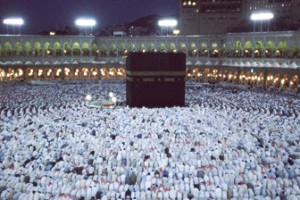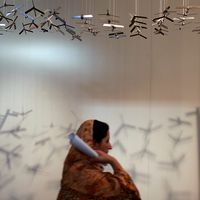Hajj: Journey to the Heart of Islam
 [/caption]
The Hajj or the pilgrimage to Mecca in Saudi Arabia, is one of the five pillars of Islam. It is the pilgrimage that every Muslim must make at least once in their lifetime if they are able. This major exhibition at the British Museum, London charts the history of this spiritual journey.
Examining the extraordinary travel logistics involved and how the wider operation of the event has changed over time, the exhibition compares how pilgrims over the centuries negotiated this journey and how the pilgrimage continues to be experienced by people from all corners of the globe today.
[/caption]
The Hajj or the pilgrimage to Mecca in Saudi Arabia, is one of the five pillars of Islam. It is the pilgrimage that every Muslim must make at least once in their lifetime if they are able. This major exhibition at the British Museum, London charts the history of this spiritual journey.
Examining the extraordinary travel logistics involved and how the wider operation of the event has changed over time, the exhibition compares how pilgrims over the centuries negotiated this journey and how the pilgrimage continues to be experienced by people from all corners of the globe today.
[caption id="attachment_2801" align="alignleft" width="300" caption="Hajj certificate (detail). 17th–18th century AD. Nasser D. Khalili Collection of Islamic Art (Khalili Family Trust)."]Haji: Journey to the Heart of Islam
'This exhibition will enable a global audience to deepen their understanding of the significance and history of the Hajj. In particular, it will allow non-Muslims to explore the one aspect of Islamic practice and faith which they are not able to witness, but which plays such a major part in forming a worldwide Islamic consciousness.' Neil MacGregor, Director, British Museum
 [/caption]
Various loans have been sourced for this exhibition including significant material from Saudi Arabia like a seetanah which covers the door of the Ka’ba as well as other historic and contemporary artefacts from key museums in the Kingdom. Other objects come from major public and private collections in the United Kingdom like the British Library and the Khalili Family Trust.
These objects evoke and document the long and perilous journey associated with the Hajj, gifts offered to the sanctuary as acts of devotion and the souvenirs that are brought back. They include archaeological material, manuscripts, textiles, historic photographs and contemporary art. The Hajj has a deep emotional and spiritual significance for Muslims, and continues to inspire a wide range of personal, literary and artistic responses, many of which are explored in the exhibition.
This exhibition concludes the British Museum’s series of three exhibitions focused on spiritual journeys.
[/caption]
Various loans have been sourced for this exhibition including significant material from Saudi Arabia like a seetanah which covers the door of the Ka’ba as well as other historic and contemporary artefacts from key museums in the Kingdom. Other objects come from major public and private collections in the United Kingdom like the British Library and the Khalili Family Trust.
These objects evoke and document the long and perilous journey associated with the Hajj, gifts offered to the sanctuary as acts of devotion and the souvenirs that are brought back. They include archaeological material, manuscripts, textiles, historic photographs and contemporary art. The Hajj has a deep emotional and spiritual significance for Muslims, and continues to inspire a wide range of personal, literary and artistic responses, many of which are explored in the exhibition.
This exhibition concludes the British Museum’s series of three exhibitions focused on spiritual journeys.
Similar content
from - to
20 Aug 2013 - 20 Nov 2013
from - to
02 Sep 2011 - 08 Apr 2012
from - to
17 Dec 2011 - 03 Jun 2012
from - to
01 Nov 2010 - 31 Mar 2011
from - to
30 Mar 2012 - 29 Jun 2012


